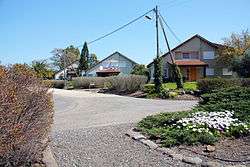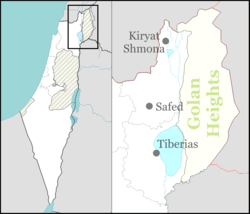Kanaf
| Kanaf כָּנָף | |
|---|---|
 | |
 Kanaf | |
| Coordinates: 32°52′11.27″N 35°42′1.79″E / 32.8697972°N 35.7004972°ECoordinates: 32°52′11.27″N 35°42′1.79″E / 32.8697972°N 35.7004972°E | |
| District | Northern |
| Council | Golan |
| Region | Golan Heights |
| Affiliation | Moshavim Movement |
| Founded | 1985 |
| Population (2015)[1] | 419 |
| Name meaning | Wing |
Kanaf (Hebrew: כָּנָף) is an Israeli settlement and moshav shitufi located in the southern Golan Heights, under the administration of Israel. One of four Golan settlements that overlook the Sea of Galilee,[2] it falls under the jurisdiction of Golan Regional Council. The settlement began to be populated in 1991,[3] and had a population of 419 in 2015.
The international community considers Israeli settlements in the Golan Heights illegal under international law, but the Israeli government disputes this.[4]
History
The establishment of Kanaf was approved by the government in the summer of 1984. In April 1985, members of the settlement group moved to a temporary site at Moshav Eliad for six years. In 1991, they moved to a permanent location near Mazra'at Kanaf.[5] Some of the residents were veterans of the Israeli Navy.[6][7]
Ancient synagogue
Near Kanaf, on the west bank of the Kanaf River, are the remains of a Byzantine-era synagogue. Called the Dir Aziz synagogue, it was first described by Laurence Oliphant in 1885. In his report were details of an extant three-meter-high wall, but it is believed to have collapsed in a 1920 earthquake. Features of the synagogue that have survived include a basalt stone floor, remains of eight pillars, and three benches. Archeologists recovered hundreds of Byzantine coins from beneath the floor of the synagogue. Olive presses, s cemetery and what may be a pottery workshop were documented in surveys of the site. In 1998–2004, excavation of the synagogue uncovered a unique basilica structure, an apse and a magnificent bema.[8]
The synagogue is unlike other Golan Heights synagogues in that when the worshipers faced south they were facing the structure's long wall rather than its wide one. In that regard, the synagogue shares a feature common to synagogues in the southern Hebron Hills.[9]
See also
References
- ↑ "List of localities, in Alphabetical order" (PDF). Israel Central Bureau of Statistics. Retrieved 16 October 2016.
- ↑ Hayoun, David (23 August 1998). "Ministerial C'tee Approves 4 Golan Heights Settlements Expansion". Globes. Retrieved 21 September 2012.
- ↑ "Israel Opens New Golan Heights Settlement". New York Times. 22 May 1991. Retrieved 21 September 2012.
- ↑ "The Geneva Convention". BBC. 10 December 2009.
- ↑ The Golan Heights: Political History, Settlement and Geography since 1949, Yigal Kipnis
- ↑ Levin, Itamar (August 2008). רווח נקי [Net Profit] (PDF) (in Hebrew). Institute of Certified Public Accountants in Israel. Retrieved 18 September 2012.
- ↑ Bekerman, Eitan (9 February 2009). "Northern exposure". Haaretz. Retrieved 21 September 2012.
- ↑ Excavations and surveys in Israel
- ↑ Shapira, Ran (23 July 2003). "When Golan worshipers faced south". Haaretz. Retrieved 21 September 2012.